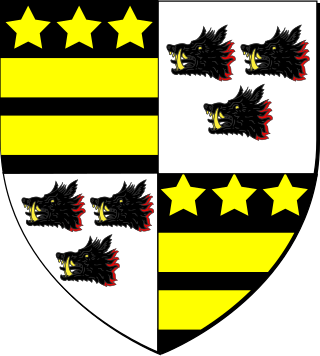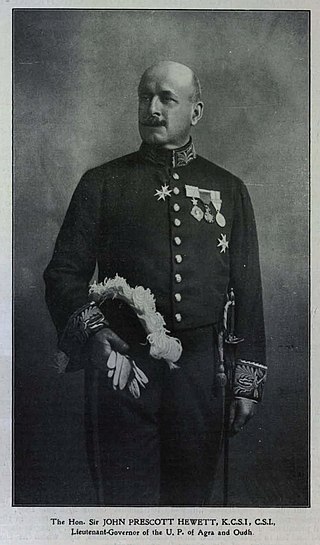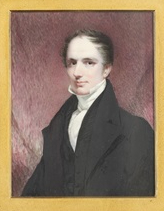
The Hewett baronetcy, of Chesterfield Street, in the parish of St George, Hanover Square in the County of Middlesex, was created in the Baronetage of the United Kingdom on 6 August 1883 for Prescott Gardner Hewett, a surgeon. [1]

The Hewett baronetcy, of Chesterfield Street, in the parish of St George, Hanover Square in the County of Middlesex, was created in the Baronetage of the United Kingdom on 6 August 1883 for Prescott Gardner Hewett, a surgeon. [1]

Baron Carbery, of Carbery in the County of Cork, is a title in the Peerage of Ireland. It was created in 1715 for George Evans, with remainder to the heirs male of his father and namesake George Evans, a supporter of William and Mary during the Glorious Revolution, who had earlier declined the offer of a peerage. After his elevation to the peerage, Lord Carbery represented Westbury in the House of Commons. He was succeeded by his eldest son, the second Baron. He also sat as Member of Parliament for Westbury. His grandson, the fourth Baron, briefly represented Rutland in Parliament. He was succeeded by his uncle, the fifth Baron. On his death, the line of the eldest son of the first Baron failed. He was succeeded by his first cousin once removed, the sixth Baron, who had previously succeeded his father as second Baronet, of Castle Freke. Lord Carbery sat in the House of Lords as an Irish Representative Peer from 1824 to 1845. His nephew, the eighth Baron, was an Irish Representative Peer from 1891 to 1894. As of 2014 the titles are held by the latter's great-great-grandson, the twelfth Baron, who succeeded his father in 2012.

Baron Glanusk, of Glanusk Park in the County of Brecknock, is a title in the Peerage of the United Kingdom. It was created in 1899 for Sir Joseph Bailey, 2nd Baronet, who had earlier represented Herefordshire and Hereford in the House of Commons as a Conservative. Both his son, the second Baron, and grandson, the third Baron, served as Lord Lieutenant of Brecknockshire. The latter was succeeded by his first cousin, the fourth Baron. He was the son of the Hon. Herbert Crawshay Bailey, fourth son of the first Baron. As of 2010 the titles are held by his son, the fifth Baron, who succeeded in 1997.
Baron Congleton, of Congleton in the County Palatine of Chester, is a title in the Peerage of the United Kingdom. It was created in 1841 for the Whig politician and former Secretary at War and Paymaster of the Forces Sir Henry Parnell, 4th Baronet. His eldest son, the second Baron, devoted his life to religious work and was an early member of the Plymouth Brethren. The latter was succeeded by his younger brother, the third Baron. He served in the Royal Navy and fought at the Battle of Navarino in 1827. His eldest surviving son, the fourth Baron, was a major-general in the British Army and served in the Crimean War and in the Anglo-Zulu War. The latter's eldest son, the fifth Baron, was killed in action in Ypres Salient during the First World War and was succeeded by his younger brother, the sixth Baron. As of 2015, the titles are held by the latter's grandson, the ninth Baron, who succeeded his father in 2015.
Sir Prescott Gardner Hewett, 1st Baronet, FRCS was a British surgeon, and the son of a Yorkshire country gentleman.

There have been four baronetcies created for persons with the surname Miller, two in the Baronetage of England, one in the Baronetage of Great Britain and one in the Baronetage of the United Kingdom. Two of the creations are extant as of 2008.

The Gibson, later Gibson-Carmichael, later Gibson-Craig-Carmichael Baronetcy, of Keirhill in the County of Edinburgh, is a title in the Baronetage of Nova Scotia. It was created on 31 December 1702 for Thomas Gibson, with remainder to his heirs male. The sixth Baronet assumed the additional surname of Carmichael. The eleventh Baronet was a Liberal politician. In 1912, he created Baron Carmichael, of Skirling in the County of Peebles, in the Peerage of the United Kingdom. The barony died in 1926, while he was succeeded in the baronetcy by his kinsman Sir Henry Thomas Gibson-Craig-Carmichael, 5th Baronet, of Riccarton, who became the twelfth Baronet of Keirhill and assumed the additional surname of Carmichael.
There have been six baronetcies created for persons with the surname King, one in the Baronetage of Ireland, one in the Baronetage of Great Britain and four in the Baronetage of the United Kingdom. Three of the creations are extant as of 2007.

The Leeds Baronetcy, of Croxton Park in the County of Cambridge, is a title in the Baronetage of the United Kingdom. It was created on 31 December 1812 for George Leeds. He was an equerry to Prince Augustus Frederick, Duke of Sussex. The Croxton Park estate in Cambridgeshire had been in the Leeds family since circa 1568. As of 2011 the presumed ninth and present Baronet, a resident of Canada, has not successfully proven his succession and is not on the Official Roll of the Baronetage.
Gardner is a male given name derived from Gardner (surname).
The Pathological Society of London was founded in 1846 for the "cultivation and promotion of pathology by the exhibition and description of specimens, drawings, microscopic preparations, casts or models of morbid parts."

The Broke, later Broke–Middleton Baronetcy, of Broke Hall in the County of Suffolk, was a title in the Baronetage of the United Kingdom. It was created on 2 November 1813 for Philip Broke, a Rear-Admiral of the Royal Navy. He was the grandson of Robert Broke, nephew of Sir Robert Broke, 1st Baronet, of Nacton, who were both descended from Sir Richard Broke, Chief Baron of the Exchequer during the reign of Henry VIII. The second Baronet was Sheriff of Suffolk in 1844 and his younger brother the third Baronet was Sheriff of Suffolk in 1864. The third Baronet assumed the additional surname of Middleton in 1860 after inheriting the estate of his cousin Sir William Fowle Fowle-Middleton. The title became extinct on his death in 1887.

The Blane Baronetcy, of Blanefield in the County of Ayr, was a title in the Baronetage of the United Kingdom. It was created on 26 December 1812 for the Scottish physician Gilbert Blane, known for his reforms in naval hygiene and medicine.
The Clinical Society of London was founded in London in 1868 and merged in 1907 with the Royal Medical and Chirurgical Society of London to form the Royal Society of Medicine (RSM).
Hewett is a surname. Notable people with the surname include:

Sir John Prescott Hewett was a British Indian civil servant who served as Lieutenant Governor of the United Provinces of Agra and Oudh and later as a Conservative MP for Luton.
John Hewett, Vicar of Babbacombe was a High Church Anglican priest and founder of the church of All Saints', Babbacombe and a friend and confidant of Anne Sutherland-Leveson-Gower, Duchess of Sutherland as well as the priest for Alexandra of Denmark whilst Princess of Wales. Hewett was also father of Sir John Prescott Hewett and of Rear Admiral George Hayley Hewett.

Cornwallis Hewett FRSC was a physician who served as Downing Professor of Medicine and Physician-Extraordinary to the King. His younger half-brother Prescott Gardner Hewett also served as Physician-Extraordinary as well as Serjeant Surgeon.
John Short Hewett was an Anglican priest and academic who served as Chaplain and Fellow of Downing College, Cambridge, Fellow of Clare College, Cambridge, Chaplain to the Forces and Rector of Rotherhithe. He came from a distinguished family, his brother was Dr Cornwallis Hewett, his half-brother was Sir Prescott Gardner Hewett, 1st Bt., he was father to Rev. John Hewett and grandfather to Sir John Prescott Hewett and Rear Admiral George Hayley Hewett and his nephew became Vice-Admiral Sir William Nathan Wrighte Hewett,.

The Hewett Baronetcy, of Nether Seale in the County of Leicester, was created in the Baronetage of the United Kingdom on 6 November 1813 for General George Hewett, Commander-in-Chief of the Forces in India in 1807. The 2nd baronet was a colonel in the army and served in the Peninsular War.
The St Paul baronetcy, of Ewart Park, was a title in the Baronetage of the United Kingdom. It was created on 17 November 1813 for Horace St Paul, Member of Parliament for Bridport. The second baronet was member of parliament for Worcestershire East and served as High Sheriff of Northumberland in 1851. The title became extinct on his death in 1891.